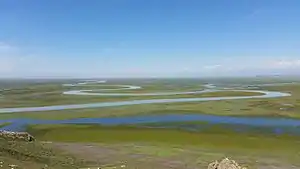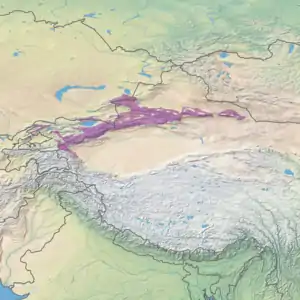Tian Shan montane steppe and meadows
The Tian Shan montane steppe and meadows ecoregion (WWF ID:PA1019) covers a 2,000 km long stretch of grasslands of the isolated Tian Sham mountains of Central Asia. It is characterized by high-altitude flat and rolling grasslands.[1][2]
| Ecoregion: Tian Shan montane steppe and meadows | |
|---|---|
 Kaidu River, Bayanbulak Grassland National Nature Reserve, in the ecoregion | |
 Ecoregion territory (in purple) | |
| Ecology | |
| Realm | Palearctic |
| Biome | Montane grasslands and shrublands |
| Geography | |
| Area | 280,000 km2 (110,000 sq mi) |
| Countries | China, Kyrgyzstan, Tajikistan |
| Coordinates | 44°15′N 85°45′E |
Location and description
The ecoregion stretches around the lower altitudes of the Tian Shan mountain ridge, running for approximately 2,000 km from western Kyrgyzstan to eastern Xinjiang Province in China.[1] It separates the arid Tarim Basin and Taklimakan Desert to the south from the Junggar Basin and Kazakh Shield to the north. Running up the middle of the ecoregion is the main ridge of the Tian Shan, with some middle altitudes supporting conifer forests in the Tian Shan montane conifer forests ecoregion.
Climate
The climate of the ecoregion is cold semi-arid (Köppen climate classification (BSk)). This climate is generally characterized as having precipitation greater than a true desert, and also a colder temperature.[3][4]
Flora and fauna
Biodiversity in the ecoregion is relatively high due to the extreme altitude range, supporting different species at different elevation levels, and due to the relatively large size of the ecoregion and its relatively central location between different floristic zones. The lowest elevations - 1,100 to 2,700 meters - are mostly grasslands of fescue (Festuca) and feather grass (Stipa). In the alpine region above 2,700 meters there are meadows of Kobresia and Carex sedges.
References
- "Tian Shan montane steppe and meadows". World Wildlife Federation (WWF). Retrieved December 28, 2019.
- "Map of Ecoregions 2017". Resolve, using WWF data. Retrieved September 14, 2019.
- Kottek, M., J. Grieser, C. Beck, B. Rudolf, and F. Rubel, 2006. "World Map of Koppen-Geiger Climate Classification Updated" (PDF). Gebrüder Borntraeger 2006. Retrieved September 14, 2019.CS1 maint: multiple names: authors list (link)
- "Dataset - Koppen climate classifications". World Bank. Retrieved September 14, 2019.